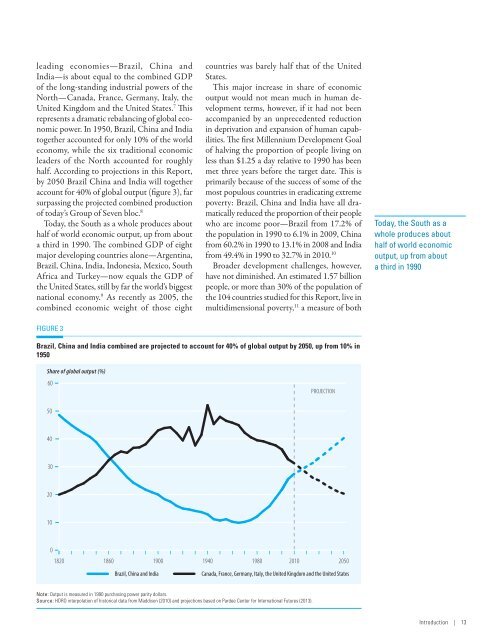E S N W
E S N W
E S N W
Create successful ePaper yourself
Turn your PDF publications into a flip-book with our unique Google optimized e-Paper software.
leading economies—Brazil, China and<br />
India—is about equal to the combined GDP<br />
of the long- standing industrial powers of the<br />
North—Canada, France, Germany, Italy, the<br />
United Kingdom and the United States. 7 This<br />
represents a dramatic rebalancing of global economic<br />
power. In 1950, Brazil, China and India<br />
together accounted for only 10% of the world<br />
economy, while the six traditional economic<br />
leaders of the North accounted for roughly<br />
half. According to projections in this Report,<br />
by 2050 Brazil China and India will together<br />
account for 40% of global output (figure 3), far<br />
surpassing the projected combined production<br />
of today’s Group of Seven bloc. 8<br />
Today, the South as a whole produces about<br />
half of world economic output, up from about<br />
a third in 1990. The combined GDP of eight<br />
major developing countries alone—Argentina,<br />
Brazil, China, India, Indonesia, Mexico, South<br />
Africa and Turkey—now equals the GDP of<br />
the United States, still by far the world’s biggest<br />
national economy. 9 As recently as 2005, the<br />
combined economic weight of those eight<br />
FIGURE 3<br />
countries was barely half that of the United<br />
States.<br />
This major increase in share of economic<br />
output would not mean much in human development<br />
terms, however, if it had not been<br />
accompanied by an unprecedented reduction<br />
in deprivation and expansion of human capabilities.<br />
The first Millennium Development Goal<br />
of halving the proportion of people living on<br />
less than $1.25 a day relative to 1990 has been<br />
met three years before the target date. This is<br />
primarily because of the success of some of the<br />
most populous countries in eradicating extreme<br />
poverty: Brazil, China and India have all dramatically<br />
reduced the proportion of their people<br />
who are income poor—Brazil from 17.2% of<br />
the population in 1990 to 6.1% in 2009, China<br />
from 60.2% in 1990 to 13.1% in 2008 and India<br />
from 49.4% in 1990 to 32.7% in 2010. 10<br />
Broader development challenges, however,<br />
have not diminished. An estimated 1.57 billion<br />
people, or more than 30% of the population of<br />
the 104 countries studied for this Report, live in<br />
multidimensional poverty, 11 a measure of both<br />
Brazil, China and India combined are projected to account for 40% of global output by 2050, up from 10% in<br />
1950<br />
Share of global output (%)<br />
60<br />
50<br />
40<br />
30<br />
20<br />
10<br />
0<br />
1820<br />
1860<br />
1900<br />
Brazil, China and India<br />
1940<br />
1980<br />
2010<br />
2050<br />
Canada, France, Germany, Italy, the United Kingdom and the United States<br />
Note: Output is measured in 1990 purchasing power parity dollars.<br />
Source: HDRO interpolation of historical data from Maddison (2010) and projections based on Pardee Center for International Futures (2013).<br />
PROJECTION<br />
Today, the South as a<br />
whole produces about<br />
half of world economic<br />
output, up from about<br />
a third in 1990<br />
Introduction | 13


